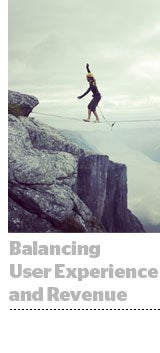Removing a bad ad unit can mean that publishers take a big revenue hit.
The most intrusive ad units often please advertisers and drive large amounts of revenue. And a heavy ad load brings in more revenue per page view.
So how do publishers balance the two? And when do they decide to pull the plug on an ad experience that just isn’t working for their readers?
Publishers like The Washington Post, Fusion Media Group and Time Inc. have all removed ad units to improve the user experience.
And in some cases, the short-term pain leads to long-term gains.
Ads With Low Viewability
The Washington Post had a bottom-of-page ad unit that drove a sizable amount of revenue each year. But viewability was low, and so was performance.
Jason Tollestrup, director of programmatic advertising and business intelligence, made the case to remove the ad unit in late 2015 because it didn’t work for advertisers. The company removed the unit, expecting to see the same amount of revenue evaporate from its bottom line.
Instead, annual revenue grew.
The unit’s low viewability had dragged down the site’s viewability scores. At the time, many viewability vendors measured on the site level, not the ad unit level. Removing the bad unit made CPMs on the rest of its ads rise.
The Washington Post continues to see that creating a better user experience and ad units drives results, as illustrated by Zeus, its extremely fast-loading ad tech rolled out over the past year.
“Programmatic CPMs were definitely higher in Zeus pages than non-Zeus pages,” Tollestrup said.
Turning To Custom Units
Over the past two years, Time Inc. has made many tweaks to slowly improve the ad experience on mobile.
The publisher used to run mobile ad units when a user first landed on the page, but readers bounced.
“If they show up on your site and are blocked from reading the content, it’s so easy to back out and go somewhere else,” said Kavata Mbondo, VP of digital revenue strategy and operations.
The publisher looked to replace the interstitial with an ad unit that boosted revenue instead of bounce rates.
This year, it also launched its Adapt unit, which is in-feed mobile video that runs within the content, not before it.
“It’s a proprietary format that runs in a space traditional banners have run, but we are customizing it to take in higher-impact experiences like video,” Mbondo said. “We have better page performance and user experience, and CPMs are higher because we have fewer ads.”
The Power Of A/B Testing
A couple years ago, Gizmodo Media Group ran interstitial video that would pop up one to two seconds after a user started scanning the article. Even with a frequency cap of one per 24 hours, complaints mounted.
“We had a very high volume of external and internal complaints, including in our comments,” said Lauren Bertollini, SVP of product for Fusion Media Group and COO of Gizmodo Media Group.
The publisher decided to replace the unit with outstream video. The viewability of the ad unit averaged slightly lower, but the steep dive in user complaints made up for the switch. And because users find outstream video less annoying than interstitials, it can run more video than before.
To protect the user experience, the company now conducts A/B testing before rolling out any significant ad changes. Due to the testing, one potentially disruptive unit that was developed in 2016 never left production.
The ad unit ran between comment threads. It marginally increased the number of ad impressions per page view, but at a huge cost to the user experience.
The A/B testing revealed that putting in the ad unit decreased engagement with comment threads. People stopped leaving as many comments and spent less time reading them.
The unit never left testing.
A/B testing ensures the long-term health of its audience, Bertollini said. “We’ve built a large, loyal audience because we’ve put readers first,” she added. “That’s what our ad partners come for. User experience is always front-of-mind for us.”















